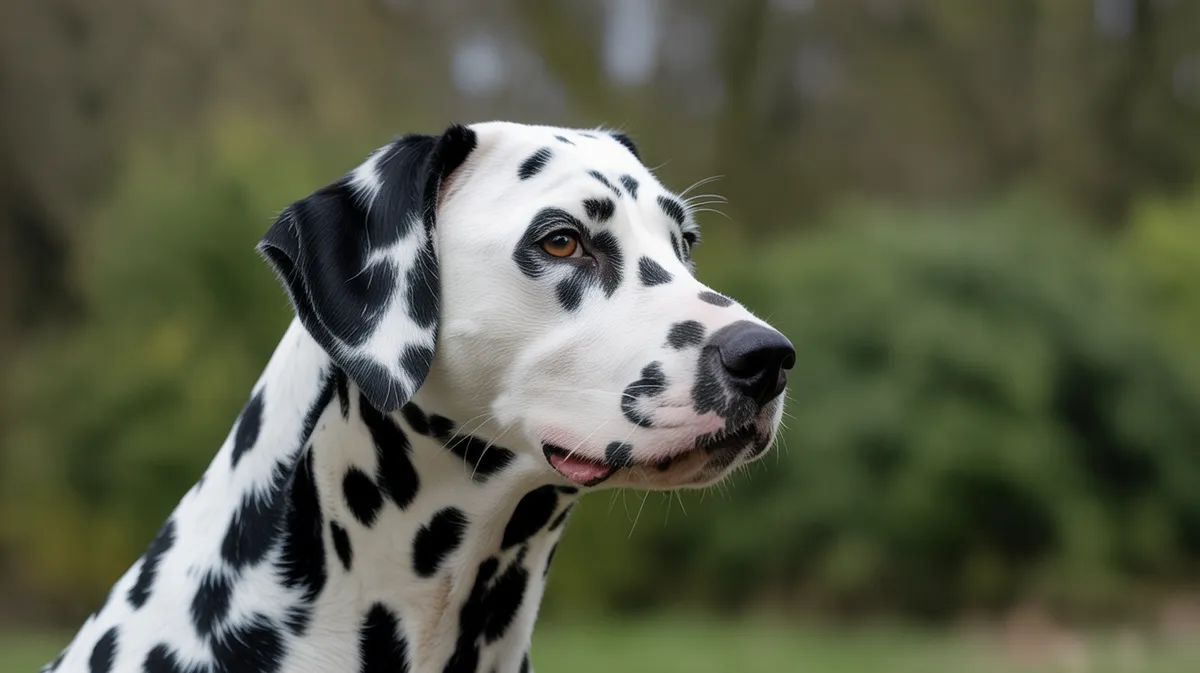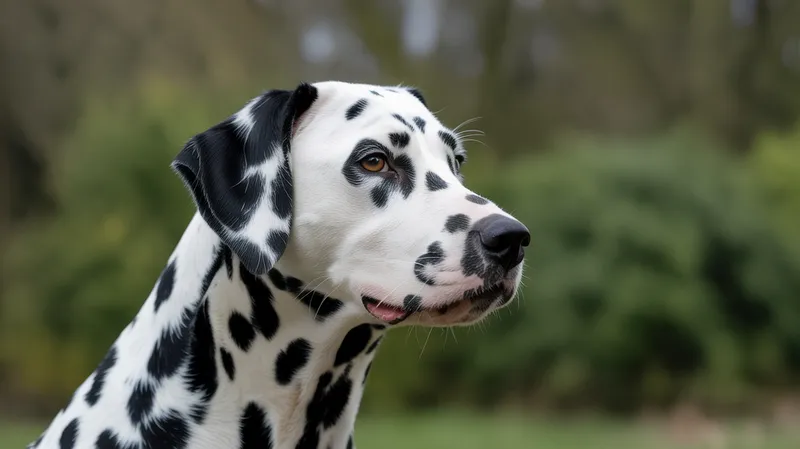
Dalmatian
Canis lupus familiaris

Meet the Dalmatian
The Dalmatian is a medium-sized breed of dog known for its distinctive white coat adorned with black or liver-colored spots. Originally bred as a carriage dog in Dalmatia, Croatia, it was used to guard horses and coaches. Dalmatians are intelligent, energetic, and highly trainable, making them excellent companions for active families. They are also known for their loyalty, playful nature, and strong endurance, which have made them popular as firehouse mascots and performers in circuses.
Classification
Mammal
Habitat
Domestic
Diet
Omnivore
Lifespan
11-13 years
Conservation
Least Concern
Weight
23-32 kg
📖Fascinating Facts
Spotted Coats
Dalmatian puppies are born pure white and their distinctive spots begin to appear at about 2-4 weeks of age.
Firehouse Mascots
Dalmatians became iconic firehouse dogs in the 1800s, running alongside horse-drawn fire wagons and guarding the equipment.
High Energy
These dogs are extremely energetic and require plenty of exercise and mental stimulation to stay happy and healthy.
📋Detailed Description
The Dalmatian (Canis lupus familiaris) is a distinctive, medium-sized dog breed renowned for its unique coat pattern of well-defined black or liver-colored spots on a white background. Adult Dalmatians typically stand 48–61 cm (19–24 in) at the shoulder and weigh between 20–32 kg (45–70 lbs), with males generally larger than females. Their short, dense coat is fine and glossy, requiring regular grooming to manage shedding. Dalmatians possess a well-muscled, athletic build, deep chest, and long, tapering tail, reflecting their historical role as carriage dogs capable of running long distances. They have a broad, flat skull, moderately long muzzle, and expressive, medium-sized eyes that may be brown or blue, sometimes displaying heterochromia. Highly energetic and intelligent, Dalmatians are known for their stamina, agility, and alertness. Socially, they form strong bonds with their human families and can be reserved with strangers. The breed is also notable for a genetic predisposition to congenital deafness, affecting approximately 15–30% of individuals. Dalmatians are long-lived for their size, with a typical lifespan of 11–13 years, though some may reach 16 years or more with proper care. Their history as coach dogs and firehouse mascots has contributed to their enduring popularity and cultural visibility.
💡 Did you know?
Every Dalmatian has a unique pattern of spots, much like a human fingerprint.
🔬Research & Sources
Wikipedia Summary
Dalmatian may refer to:Dalmatia, a region mainly in the southern part of modern Croatia Dalmatian language, an extinct Romance language Dalmatian, one of the historical names for proto-Serbo-Croatian Dalmatian identity, a historical identity in the region Dalmatian dog, a breed of dog originating in this region Dalmatian (band), a South Korean boy band Dalmatian (EP), its self-titled EP Dalmatian pelican, a large bird native to central Europe
Last Modified: 10/26/2024
🎭Behavior & Social Structure
Dalmatians are highly active and require significant daily exercise to maintain their physical and mental health. They display playful, exuberant behavior and are known for their endurance, often enjoying running, hiking, and canine sports such as agility or flyball. As descendants of working dogs, they exhibit strong guarding instincts and may be territorial, making them effective watchdogs. Socially, Dalmatians thrive on companionship and can develop separation anxiety if left alone for extended periods. They are generally sociable with other dogs and children when properly socialized from an early age. Feeding behavior is typical of domestic dogs, with a preference for high-quality, balanced diets; however, they are prone to forming urinary stones (urate urolithiasis) due to a unique metabolic trait, so dietary management is important. Dalmatians communicate through a range of vocalizations, body language, and facial expressions, and they respond well to positive reinforcement training methods.
👶Reproduction & Life Cycle
Dalmatians reach sexual maturity between 6 and 12 months, with optimal breeding age typically between 2 and 5 years. The breed is monoestrous, with females coming into heat approximately twice a year. Mating is usually natural, though artificial insemination is sometimes used in breeding programs. The gestation period averages 63 days. Litter sizes are relatively large, commonly ranging from 6 to 9 puppies, though litters of up to 15 are not uncommon. Puppies are born with solid white coats; their characteristic spots begin to emerge within 10–14 days after birth and continue to develop for several months. Parental care is primarily provided by the dam, who nurses and cleans the puppies until weaning at 6–8 weeks. Responsible breeders routinely test for congenital deafness and other hereditary conditions to ensure healthy offspring.
🛡️Adaptations & Survival
The Dalmatian's most notable adaptation is its unique spotted coat, which provides a degree of camouflage and individual identification. Their lean, muscular physique and high aerobic capacity are evolutionary adaptations for endurance running, a necessity in their historical role as carriage dogs. Dalmatians have a strong prey drive and acute senses of smell and hearing, traits inherited from their ancestors used for hunting and guarding. The breed possesses a metabolic adaptation affecting purine metabolism, leading to increased uric acid excretion; while this can predispose them to urinary stones, it may have conferred some unknown selective advantage in their past. Their intelligence and trainability are behavioral adaptations that have facilitated their use in diverse roles, from firehouse mascots to circus performers.
📚Research Sources
🎨Cultural Significance
Dalmatians have a rich cultural legacy, especially in Europe and North America. Historically, they served as carriage dogs, running alongside horse-drawn coaches to protect passengers and horses, a role that cemented their association with nobility and fire brigades. In the 19th and early 20th centuries, they became iconic firehouse mascots, often living in fire stations and running with horse-drawn fire engines. The breed's popularity surged with the publication of Dodie Smith's novel 'The Hundred and One Dalmatians' and its subsequent Disney adaptations. Dalmatians are frequently depicted in art, literature, and popular media, symbolizing loyalty, protection, and elegance. They have also been used in circuses and as status symbols in various societies.
🔬Recent Research & Discoveries
Recent genetic studies have elucidated the link between the MITF gene and the Dalmatian's unique coat pattern and deafness predisposition. Ongoing research focuses on reducing the incidence of hereditary deafness through selective breeding and BAER (Brainstem Auditory Evoked Response) testing. Veterinary studies continue to investigate optimal dietary strategies for managing urate metabolism and preventing urinary stones. Behavioral research highlights the importance of early socialization and positive reinforcement training to mitigate potential behavioral issues. Population genetics research is also being conducted to maintain genetic diversity and reduce the prevalence of inherited disorders.
🎥Wildlife Videos

Wildlife Stories: Love is in the Wild | SPECIAL | Free Documentary Nature
Wildlife Stories: Love is in the Wild | Special | Free Documentary Nature Watch 'Wildlife Stories: Talking to Survive' here: ...
Free Documentary - Nature

Wildlife - The Fascinating World of Wild Animals | Full Series | Free Documentary Nature
Wildlife - The Fascinating World of Wild Animals | Wildlife Documentary Watch 'Ocean Stories - Full Series' here: ...
Free Documentary - Nature

Our Planet | From Deserts to Grasslands | FULL EPISODE | Netflix
Experience our planet's natural beauty and examine how climate change impacts all living creatures in this ambitious ...
Netflix

The Unique Wildlife of Brazil’s Rainforest
Explore the incredible biodiversity and unique ecosystems of Brazil's Mata Atlântica and other regions. The show delves into the ...
Real Wild

The Wonder of America's National Parks | MEGA EPISODE Season 1 Full Episode
America's National Parks depicts the adventure, beauty and wonder of natural spaces. Each park is a valuable and important ...
National Geographic

The Incredible Wildlife Living At Our Equator | Equator Specials
The sun shines most powerfully at the Equator, here it is able to power extraordinary life. From the large trees covering the ...
All Out Wildlife
🌍Habitat Information
The Dalmatian typically inhabits Domestic environments. Dalmatians have adapted to their environments with specialized features and behaviors.
Primary Habitat:
Domestic
More detailed habitat information will be available soon.
🛡️Conservation Status
The Dalmatian is currently classified as Least Concern. Conservation efforts are crucial for preserving this species for future generations.
Common Threats:
- 🏠Habitat loss and fragmentation
- 🌡️Climate change impacts
- 🎯Hunting and poaching
- 🏭Human-wildlife conflict
⚠️Threats & Conservation Challenges
While Dalmatians are not threatened in the wild and are classified as 'Least Concern' due to their domestic status, they face several breed-specific challenges. The most significant is congenital deafness, with up to 30% of individuals affected in one or both ears due to a genetic mutation linked to their piebald coat pattern. The breed is also predisposed to urate urolithiasis, requiring careful dietary management. Overbreeding and irresponsible breeding practices have led to health and temperament issues in some populations. In some regions, Dalmatians are abandoned or surrendered due to their high energy levels and exercise needs, which can be challenging for unprepared owners. Ethical breeding, public education, and breed-specific rescue efforts are ongoing to address these concerns.
🔬Scientific Classification
Scientific Name
Canis lupus familiaris
Classification Hierarchy
🔍 About Taxonomic Classification
Taxonomic classification is a hierarchical system used by scientists to classify and organize living organisms based on shared characteristics and evolutionary relationships.
The system moves from broad categories (Kingdom) to increasingly specific ones, with each animal's scientific name typically consisting of its Genus and species.
📝Community Notes
Share your observations and insights about the Dalmatian with our community of wildlife enthusiasts.
Join Our Community
Sign in to share your observations and connect with fellow wildlife enthusiasts.
Sign In to ContributeNo community notes yet
Be the first to share your observations about the Dalmatian!
Explore Dalmatian
Select a tab above to learn more about this amazing animal.
📸Photo Gallery
No photos available for this animal yet.
🌟Discover More Wildlife
Continue your journey of discovery with more fascinating animals from our database
